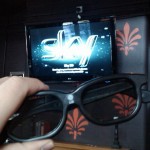Article first published as 3D TV; Must-Have Gadget or Modern Gimmick? on Technorati.
 3D TV is the latest idea to move out of the lab and in to the home. At the beginning of this month, Rupert Murdoch’s Sky TV launched Europe’s first 3D television channel, showing 14 hours of content daily. So far this has been selected films and Premiership football matches, following on from trials of the service in pubs across Britain.
3D TV is the latest idea to move out of the lab and in to the home. At the beginning of this month, Rupert Murdoch’s Sky TV launched Europe’s first 3D television channel, showing 14 hours of content daily. So far this has been selected films and Premiership football matches, following on from trials of the service in pubs across Britain.
Just like when you see a 3D film at the cinema, you need to wear special glasses. But gone are the plastic blue and red specs you pay more for at the flicks. The new generation of 3D TV uses sleek, futuristic-looking glasses. They’re not cheap, at around £100 ($158) a pair, but are of course more sturdy and reliable. The old glasses will still let you see in three dimensions, just not as well.
However, the cinema is a place where, over the last few years, people have become accustomed to picking up a pair, sitting down to watch the film and looking a bit silly. The living room is a whole new arena – are people ready to adapt?
Where is the market for non-fictional 3D content on TV? I’ve seen one or two films marketed as “3D”. One was Coraline, Henry Selick’s computer-animated adaptation of the Neil Gaiman novel. I remember a few things seemingly coming out of the screen towards me, which I presume is scary for children. But is it entertaining? Does it add anything to the plot, or is it just a gimmick? I think the latter. Warner Brothers announced last week that the planned 3D release of Harry Potter and the Deathly Hallows Part One had been cancelled as the studio was unable to ready it in time for the November release. As such, the film will only be seen in cinemas in 2D. Part Two, to be released in July next year, will also be in 3D.
I cannot see 3D being employed as a serious tool by, for example, news broadcasters, talk shows, comedy programmes or any drama series. It would ruin the feel of the programme by figuratively and, literally via technology, breaking the fourth wall.
Then there is the actual capability to view the programmes. For this, a TV with the necessary hardware built-in is required. Many people have forked out for expensive high definition televisions, and these are just now becoming the new standard available in shops. Consumers set them up to find that the quality on a small selection of programmes is only marginally better. It will be some years before HD becomes standard on the majority of television output, and surely many more years later before 3D is so – if it ever takes off properly.
Also this month, the first hardware supporting Google’s upcoming TV offering will become available, with Logitech’s Revue set to ship on October 21st and offerings from Sony and other companies debuting later this year or in early 2010. Apple also started selling its relaunched Apple TV box, first shown in September.
It seems there is a future in television, despite what the online future media nay-sayers might claim. But the content and format is certain to be very different to that seen today.
Image by user pcs007 on Flickr, used under a CC-BY-SA license.
